-

新人教版高中英语必修2Unit 2 Wildlife Protection-Listening &Speaking&Talking教案
Listening and Speaking introduces the topic of “how to save endangered wildlife and help wildlife in their neighborhood.” Due to the continuous deterioration of the living environment, a large number of wild animals are always facing the threat of endangered or extinction. Listening and speaking period enables students to understand the fact and reason why wild species are disappearing from the earth at an amazing speed, and realize that human beings ought to enhance the awareness of protecting wild species as soon as possible.Listening and Talking introduces the theme of " how to help wildlife in Ss’ neighborhood.". Now there are many volunteers who spontaneously protect wild animals, carry out various activities according to local conditions, and contribute their own strength to local animal protection with practical actions. Middle school students are also enthusiastic participants. They organize activities in their spare time, and take this opportunity to make friends, broaden their horizons, cultivate team spirit and communication skills. This section describes a bird watching activity organized by several middle school students of Bird watching Club. It aims to stimulate students' interest, improve their understanding of bird watching activities, and use the language structure of “being used for; in order to, so as to, to, so that, in order that ” to express the purpose for communication and discussion.1. Guide students to understand the content of listening texts in terms of using visuals to predict content.2. Cultivate students' ability to guess the meaning of words in listening; discuss with their peers how to save endangered wildlife and help wildlife in their neighborhood.3. Instruct students to use functional sentences of the dialogue such as “I am concerned about…” “what do you know about the endangered animals in…" and so on to talk about one of the endangered animals.

新人教版高中英语必修2Unit 2 Wildlife Protection-Listening and Speaking教案
This lesson is about wildlife protection. The listening and speaking is about “How to protect endangered wildlife ?” Faced with the facts and numbers of wildlife loss, people begin to detect the reasons, then people such as the celebrities (Prince William and Yao Ming) are calling on to protect them. So students are guided to enhance the awareness of protecting wildlife and try to take part in some volunteer activities of protecting wildlife.1. Predict the content by using visuals. 2. Learn to use the sentences such as “I’m concerned about.... But now they are in danger. I want to know the reasons/why./ What can we do to protect them ?3. Learn from the stars like Prince William and Yao Ming and enhance the awareness of protecting wildlife.4. Guide students to try to put forward the solutions to the problems of wildlife protection and then discuss them with partners and present the results of discussion.5. Master the pronunciation of stressed syllables.1. Learn from the stars like Prince William and Yao Ming and enhance the awareness of protecting wildlife.2. Guide students to try to put forward the solutions to the problems of wildlife protection and then discuss them with partners and present the results of discussion.3. Learn to use the sentences such as “I’m concerned about.... But now they are in danger. I want to know the reasons/why./ What can we do to protect them ?4. Master the pronunciation of stressed syllables.Part A Listening and Speaking--- How to save endangered wildlifeStep 1 Lead in1. Point at the pictures on P14 and ask Q1: What message do these posters share?

新人教版高中英语必修2Unit 2 Wildlife Protection-Reading and Thinking教案二
The theme of this unit is human and nature, focusing on the theme of wildlife protection. Nature is a complex ecosystem, in which there are delicate balance between animals and plants. Because of the role of the food chain, the extinction of one species will produce influence, causing a series of chain reaction. Large scale extinction of species will have a serious and even irreversible impact on the ecosystem, resulting in immeasurable losses. Therefore, it is of great significance to protect wild species. To protect wild species is to protect human beings themselves. The motto of this unit is "when the buying stops, the killing can too,” which is a public service advertising slogan to protect wildlife. It tells people that every rhinoceros horn, every fur, every bowl of shark fin soup, every Ivory product, and every tiger bone product, etc. consumed by human beings, are innocent wild animals slaughtered behind them. The mission of wild aid is to ban illegal trade in endangered wildlife and mitigate climate change. It aims to educate the public to reduce the consumption demand for endangered wildlife products through public publicity and improve the awareness of environmental protection.1. Improve the awareness of wildlife protection by acquiring the knowledge of wildlife protection.2. Focus on environmental protection and protection of all lives.3. Analysis of the living environment of wild animals with appropriate thinking mode.4. Skillfully use the vocabulary and grammar knowledge of this unit to cultivate self-study ability according to the unit content5. Develop cooperative learning ability through discussion and other ways1. Enable the Ss to talk about the current situation of wild animals.2. Guide the Ss to summarize the main idea of each paragraph as well as the main idea of the text.

人教版新课标高中物理必修2功率教案2篇
1.用CAI课件模拟汽车的启动过程。师生共同讨论:①如果作用在物体上的力为恒力,且物体以匀速运动,则力对物体做功的功率保持不变。此情况下,任意一段时间内的平均功率与任一瞬时的瞬时功率都是相同的。②很多动力机器通常有一个额定功率,且通常使其在额定功率状态工作(如汽车),根据P=FV可知:当路面阻力较小时,牵引力也小,速度大,即汽车可以跑得快些;当路面阻力较大,或爬坡时,需要比较大的牵引力,速度必须小。这就是爬坡时汽车换低速挡的道理。③如果动力机器在实际功率小于额定功率的条件下工作,例如汽车刚刚起动后的一段时间内,速度逐渐增大过程中,牵引力仍可增大,即F和v可以同时增大,但是这一情况应以二者乘积等于额定功率为限度,即当实际功率大于额定功率以后,这种情况不可能实现。
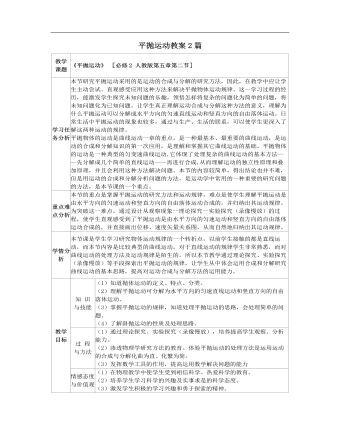
人教版新课标高中物理必修2平抛运动教案2篇
(五)平抛运动规律的应用例1:一架老式飞机在高出海面45m的高处,以80m/s的速度水平飞行,为了使飞机上投下的炸弹落在停在海面上的敌船,应该在与轰炸目标的水平距离为多远的地方投弹?不计空气阻力。分析:对于这道题我们可以从以下几个方面来考虑:(1)从水平飞行的飞机上投下的炸弹,做什么运动?为什么?(2)炸弹的这种运动可分解为哪两个什么样的分运动?3)要想使炸弹投到指定的目标处,你认为炸弹落地前在水平方向通过的距离与投弹时飞机离目标的水平距离之间有什么关系?拓展:1、式飞机在高出海面45m的高处,以80m/s的速度水平飞行,尾追一艘以15m/s逃逸的敌船,为了使飞机上投下的炸弹正好击中敌船,应该在与轰炸目标的水平距离为多远的地方投弹?不计空气阻力。2、在一次摩托车跨越壕沟的表演中,摩托车从壕沟的一侧以速度v=40m/s沿水平方向向另一侧,壕沟两侧的高度及宽度如图所示,摩托车可看做质点,不计空气阻力。(1)判断摩托车能否跨越壕沟?请计算说明(2)若能跨过,求落地速度?
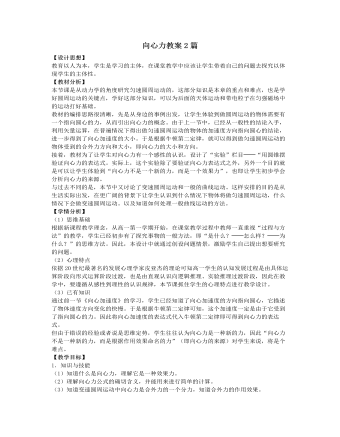
人教版新课标高中物理必修2向心力教案2篇
3.进一步体会力是产生加速度的原因,并通过牛顿第二定律来理解匀速圆周运动、变速圆周运动及一般曲线运动的各自特点。(三)、情感、态度与价值观1.在实验中,培养学生动手、探究的习惯。2.体会实验的意义,感受成功的快乐,激发学生探究问题的热情、乐于学习的品质。教学重点1.体会牛顿第二定律在向心力上的应用。2.明确向心力的意义、作用、公式及其变形,并经行计算。教学难点1.对向心力的理解及来源的寻找。2.运用向心力、向心加速度的知识解决圆周运动问题。教学过程(一)、 引入新课:复习提问:匀速圆周运动的物体的加速度——向心加速度,它的方向和大小有何特点呢?学生回答后进一步引导:那做匀速圆周运动物体的受力有什么特点呢?是什么力使物体做圆周运动而不沿直线飞出?请同学们先阅读教材
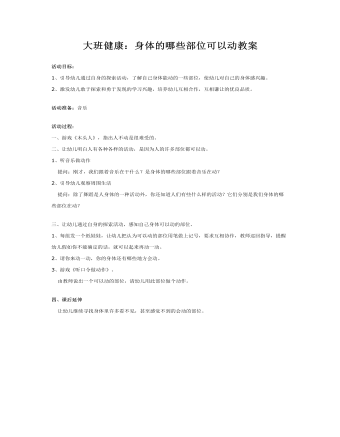
大班健康:身体的哪些部位可以动教案
2、激发幼儿敢于探索和勇于发现的学习兴趣,培养幼儿互相合作,互相谦让的优良品质。 活动准备:音乐 活动过程: 一、游戏《木头人》,指出人不动是很难受的。 二、让幼儿明白人有各种各样的活动,是因为人的许多部位都可以动。 1、听音乐做动作 提问:刚才,我们跟着音乐在干什么?是身体的哪些部位跟着音乐在动? 2、引导幼儿观察周围生活 提问:除了舞蹈是人身体的一种活动外,你还知道人们有些什么样的活动?它们分别是我们身体的哪些部位在动?
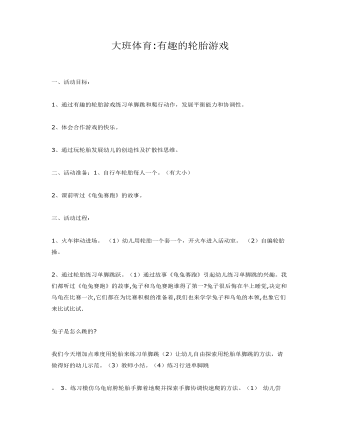
大班体育有趣的轮胎游戏课件教案
2、体会合作游戏的快乐。3、通过玩轮胎发展幼儿的创造性及扩散性思维。二、活动准备:1、自行车轮胎每人一个。(有大小)2、课前听过《龟兔赛跑》的故事。三、活动过程:1、火车律动进场。(1)幼儿用轮胎一个套一个,开火车进入活动室。(2)自编轮胎操。2、通过轮胎练习单脚跳跃。(1)通过故事《龟兔赛跑》引起幼儿练习单脚跳的兴趣。我们都听过《龟兔赛跑》的故事,兔子和乌龟赛跑谁得了第一?兔子很后悔在半上睡觉,决定和乌龟在比赛一次,它们都在为比赛积极的准备着,我们也来学学兔子和乌龟的本领,也象它们来比试比试.
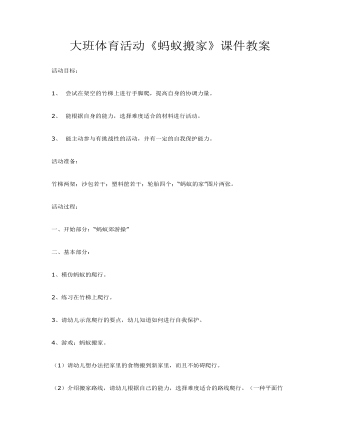
大班体育活动《蚂蚁搬家》课件教案
2、 能根据自身的能力,选择难度适合的材料进行活动。3、 能主动参与有挑战性的活动,并有一定的自我保护能力。活动准备:竹梯两架;沙包若干;塑料筐若干;轮胎四个;“蚂蚁的家”图片两张。活动过程:一、开始部分:“蚂蚁郊游操”二、基本部分:1、模仿蚂蚁的爬行。2、练习在竹梯上爬行。3、请幼儿示范爬行的要点,幼儿知道如何进行自我保护。
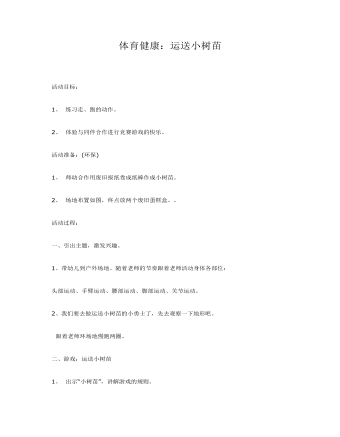
大班体育健康--运送小树苗课件教案
2、 体验与同伴合作进行竞赛游戏的快乐。活动准备:(环保)1、 师幼合作用废旧报纸卷成纸棒作成小树苗。2、 场地布置如图,终点放两个废旧蛋糕盒。。活动过程:一、引出主题,激发兴趣。1、带幼儿到户外场地。随着老师的节奏跟着老师活动身体各部位:头部运动、手臂运动、腰部运动、脚部运动、关节运动。2、我们要去做运送小树苗的小勇士了,先去观察一下地形吧。 跟着老师环场地慢跑两圈。
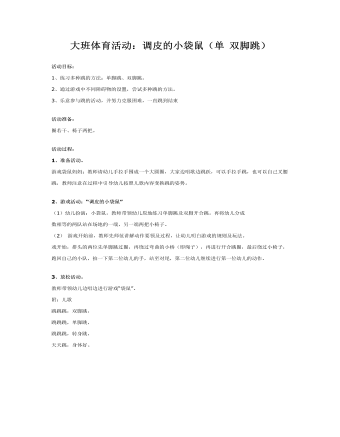
大班体育活动:调皮的小袋鼠课件教案
2、通过游戏中不同障碍物的设置,尝试多种跳的方法。 3、乐意参与跳的活动,并努力克服困难,一直跳到结束 活动准备: 圈若干、椅子两把。 活动过程: 1、准备活动。 游戏袋鼠妈妈:教师请幼儿手拉手围成一个大圆圈,大家边唱歌边跳跃,可以手拉手跳,也可以自己叉腰跳,教师注意在过程中引导幼儿按照儿歌内容变换跳的姿势。
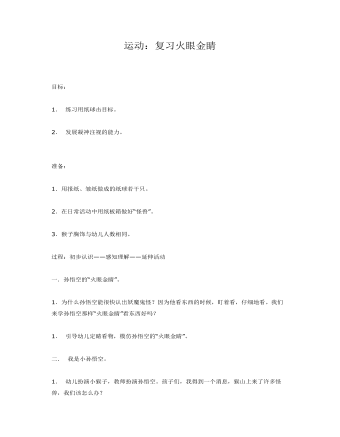
大班体育游戏复习火眼金睛课件教案
2. 发展凝神注视的能力。准备:1.用报纸、皱纸做成的纸球若干只。2.在日常活动中用纸板箱做好“怪兽”。3.猴子胸饰与幼儿人数相同。过程:初步认识——感知理解——延伸活动一.孙悟空的“火眼金睛”。1.为什么孙悟空能很快认出妖魔鬼怪?因为他看东西的时候,盯着看,仔细地看。我们来学孙悟空那样“火眼金睛”看东西好吗?1. 引导幼儿定睛看物,模仿孙悟空的“火眼金睛”。

大班健康活动《会动的身体》课件教案
3、在大胆探索、自我发现的活动中,增强活动兴趣,提高合作能力,体验愉快情绪。活动准备:纸盒制作的木头人;各种图案标记;音乐《眉飞色舞》、《兔子舞》等。活动过程:一、出示木头人,激发幼儿参与活动的兴趣。1、请出木头人,幼儿与木头人打招呼。师:小朋友们,听,是谁在哭呀?我们一起把他请出来。木头人出现提问:他是谁?木头人怎么了?他为什么不高兴呢?我们问问他。木头人讲述原因(不舒服、不能动)2、幼儿帮木头人脱掉“外衣”。请部分幼儿帮助木头人脱掉身上用纸盒做的“外衣”。3、扮演木头人的小朋友听音乐表演。
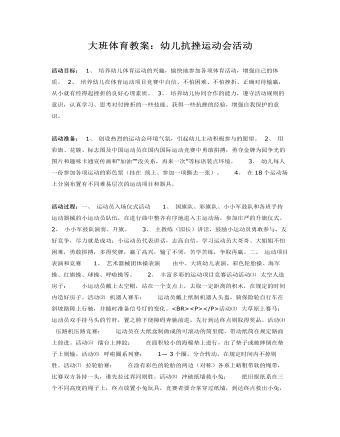
大班体育教案:幼儿抗挫运动会活动
活动准备: 1、创设热烈的运动会环境气氛,引起幼儿主动积极参与的愿望。 2、用彩旗、花簇、标志图及中国运动员在国内国际运动竞赛中勇敢拼搏,勇夺金牌为园争光的图片和趣味卡通宣传画和“加油”“没关系,再来一次”等标语装点环境。 3、幼儿每人一份参加各项运动的彩色票(挂在颈上、参加一项撕去一张)。 4、在18个运动场上分别布置有不同难易层次的运动项目和器具。 活动过程:一、运动员入场仪式活动 1、国旗队、彩旗队、小小军鼓队和各班手持运动器械的小运动员队伍,在进行曲中整齐有序地进入主运动场,参加庄严的升旗仪式。 2、小小军鼓队演奏、升旗。 3、主教练(园长)讲话,鼓励小运动员勇敢参与,友好竞争,尽力就是成功;小运动员代表讲话,志高自信,学习运动员大哥哥、大姐姐不怕困难,勇敢拼搏,多得奖牌,赢了高兴,输了不哭,苦学苦练,争取再赢。二、运动项目表演和竞赛 1、艺术器械团体操表演 由中、大班幼儿表演、彩色轮胎操、海军操、红旗操、球操、呼啦操等。
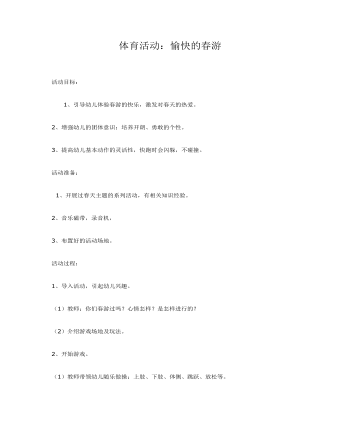
大班体育活动:愉快的春游课件教案
2、增强幼儿的团体意识;培养开朗、勇敢的个性。3、提高幼儿基本动作的灵活性,快跑时会闪躲,不碰撞。 活动准备: 1、开展过春天主题的系列活动,有相关知识经验。2、音乐磁带,录音机,3、布置好的活动场地。活动过程:1、导入活动,引起幼儿兴趣。(1)教师:你们春游过吗?心情怎样?是怎样进行的?(2)介绍游戏场地及玩法。
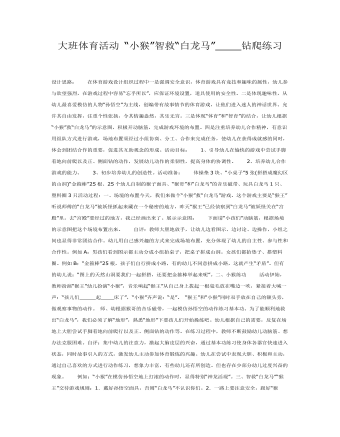
大班体育活动 “小猴”智救“白龙马”课件教案
活动目标: 1、引导幼儿在愉快的游戏中尝试手脚着地向前爬以及正、侧面钻的动作,发展幼儿动作的柔韧性,提高身体的协调性。 2、培养幼儿合作游戏的能力。 3、初步培养幼儿的创造性。活动准备: 体操垫3块、“小桌子”5张(拼搭成魔幻区的山洞)“金箍棒”25根、25个幼儿自制的猴子面具、“猴哥”和“白龙马”的音乐磁带、玩具白龙马1只、 塑料圈3只活动过程:一、场境的布置今天,我们来做个“小猴”救“白龙马”游戏。这个游戏主要是“猴王”听说师傅的“白龙马”被妖怪抓起来藏在一个秘密的地方,昨天“猴王”已经侦察到“白龙马”被妖怪关在“宫殿”里。去“宫殿”要经过的地方,我己经画出来了。展示示意图: 下面请“小孩们”动脑筋,根据场境的示意图把这个场境布置出来。 自评:教师大胆地放手,让幼儿边看图示、边讨论、边操作,小组之间也显得非常团结合作。幼儿用自己感兴趣的方式来完成场境布置,充分体现了幼儿的自主性、参与性和合作性。例如A:男孩们看到图示都主动分成小组抬桌子,把桌子拼成山洞。女孩们都抬垫子、搭塑料圈。例如B:“金箍棒”25根,孩子们自行拼成小路,有的幼儿不同意拼成小路,这就产生“矛盾”。但有的幼儿说:“图上的天然山洞要我们一起拼搭,还要把金箍棒举起来呢”。二、小猴练功 活动伊始,教师扮演“猴王”幼儿扮演“小猴”,音乐响起“猴王”从自己身上拔起一根毫毛放在嘴边一吹,紧接着大喊一声:“孩儿们_____起____床了”,“小猴”齐声说:“是”。 “猴王”和“小猴”同时双手放在自己的额头旁,做观察事物的动作。 师、幼根据猴哥的音乐磁带,一起模仿孙悟空的动作练习基本功。为了能顺利地救出“白龙马”,我们必须了解“地形”,熟悉“地形”下要孩儿们开始操练吧。幼儿根据自己的需要,反复在场地上大胆尝试手脚着地向前爬行以及正、侧面钻的动作等。在练习过程中,教师不断鼓励幼儿动脑筋、想办法克服困难。自评:集中幼儿的注意力,激起大脑皮层的兴奋,通过基本功练习使身体各器官快速进入状态,同时故事引入的方式,激发幼儿主动参加体育锻炼的兴趣。幼儿在尝试中表现大胆、积极和主动,通过自己喜欢的方式进行动作练习,想象力丰富,有些幼儿还有所创造。但也存在少部分幼儿过度兴奋的现象。 例如:“小猴”在模仿孙悟空地上打滚的动作时,显得特别“神龙活现”。
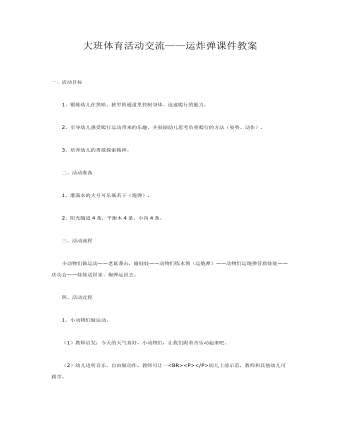
大班体育活动交流——运炸弹课件教案
2、引导幼儿感受爬行运动带来的乐趣,并鼓励幼儿思考负重爬行的方法(姿势、动作)。3、培养幼儿的勇敢探索精神。 二、活动准备1、灌满水的大号可乐瓶若干(炮弹)。2、阳光隧道4条,平衡木4条,小沟4条。 三、活动流程 小动物们做运动——老鼠袭击,偷娃娃——动物们练本领(运炮弹)——动物们运炮弹营救娃娃——庆功会——娃娃送回家、炮弹运回去。
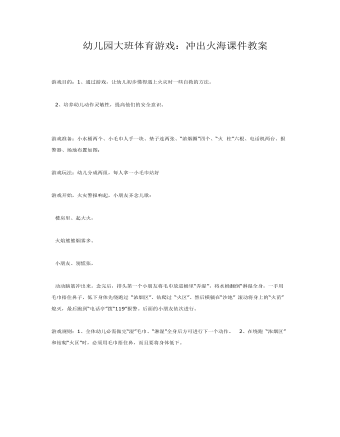
幼儿园大班体育游戏:冲出火海课件教案
2、培养幼儿动作灵敏性,提高他们的安全意识。游戏准备:小水桶两个、小毛巾人手一块、垫子连两张、“浓烟圈”四个、“火 柱”六根、电话机两台、报警器、场地布置如图: 游戏玩法:幼儿分成两组,每人拿一小毛巾站好游戏开始,火灾警报响起,小朋友齐念儿歌: 楼房里、起大火, 火焰熊熊烟雾多。 小朋友、别慌张,
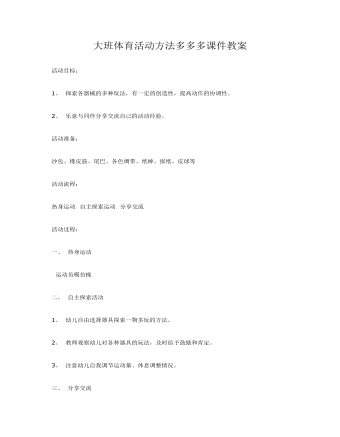
大班体育活动方法多多多课件教案
2、 乐意与同伴分享交流自己的活动经验。活动准备:沙包、橡皮筋、尾巴、各色绸带、纸棒、报纸、皮球等活动流程:热身运动 自主探索运动 分享交流 活动过程: 一、 热身运动 运动员模仿操
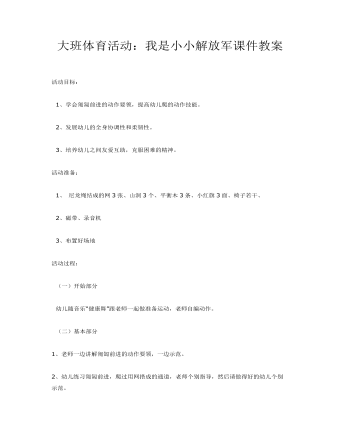
大班体育活动:我是小小解放军课件教案
2、发展幼儿的全身协调性和柔韧性。 3、培养幼儿之间友爱互助,克服困难的精神。活动准备: 1、尼龙绳结成的网3张、山洞3个、平衡木3条、小红旗3面、椅子若干、 2、磁带、录音机 3、布置好场地活动过程: (一)开始部分 幼儿随音乐“健康舞”跟老师一起做准备运动,老师自编动作。

